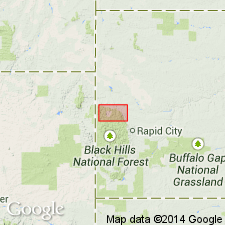
- Usage in publication:
-
- SCOLITHUS quartzite*
- Modifications:
-
- Named
- Dominant lithology:
-
- Sandstone
- AAPG geologic province:
-
- Williston basin
- Powder River basin
Summary:
Named informally for a bed in the Cambrian sequence in the northern Black Hills, SD and WY, in the Williston and Powder River basins. Identified in generalized descriptions of the Cambrian rocks as the hard, "worm-eaten" quartzite, jutting out from beneath thick, soft, green shales immediately below the Silurian limestone. Thickness 5-12 ft. Middle Cambrian in age.
Source: GNU records (USGS DDS-6; Denver GNULEX).
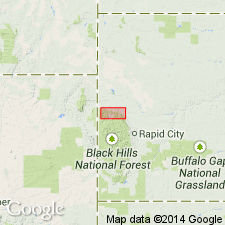
- Usage in publication:
-
- SCOLITHUS quartzite*
- Modifications:
-
- Revised
- AAPG geologic province:
-
- Williston basin
Summary:
Identified as an informally named bed in the upper part of Deadwood formation, vicinity of Deadwood, Lawrence Co, SD, in Williston basin. [Middle Cambrian in age.]
Source: GNU records (USGS DDS-6; Denver GNULEX).
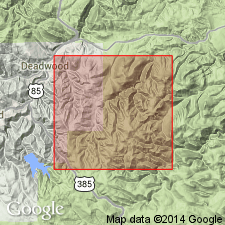
- Usage in publication:
-
- SCOLITHUS sandstone member
- Modifications:
-
- Overview
- AAPG geologic province:
-
- Williston basin
Summary:
Made top "member" of Deadwood formation (revised) at Deadwood, Lawrence Co, SD, Williston basin. Is persistent and easily recognized in northern Black Hills (and at Sheep Mountain, farther west, in Powder River basin). Good exposures seen in canyons of Whitewood, Spearfish, Two Bit, and Bear Butte Creeks, Lawrence Co, SD. Near Deadwood, consists of about 15 ft of reddish-brown, coarse-grained, quartzitic sandstone, commonly cross-bedded and rarely ripple marked, which contains many "worm-borings". Typically about 10-15 ft thick in northern Black Hills; basal part exposed at few localities and in these it is difficult to "draw a line" between SCOLITHUS and underlying beds. Near Deadwood, where entire member exposed in fresh roadcut, quartzitic beds with "worm borings" seem to grade into underlying sandy beds. On Little Elk Creek, about 15 mi southeast of Deadwood and near southernmost extension of Whitewood dolomite, is abnormally thick, red color. Over entire area of outcrop, is overlain by a gray fissile shale which presents an abrupt change in lithologic character. SCOLITHUS-shale contact is quite distinct, but lower part of shale contains many sand grains probably derived from underlying sandstone. Upper surface of SCOLITHUS irregular, locally dark red; color, as well as sandstone silicification, may be partially due to a period of exposure. No diagnostic fossils--age therefore questionable. Tentatively classed with Deadwood.
Source: GNU records (USGS DDS-6; Denver GNULEX).
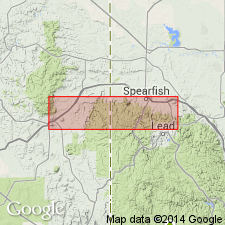
- Usage in publication:
-
- SCOLITHUS sandstone
- Modifications:
-
- Not used
Summary:
Renamed Aladdin sandstone (new); replaces name SCOLITHUS [SCOLITHOS] sandstone in outcrops in northern Black Hills and Bearlodge Mountains, SD and WY, in Williston and Powder River basins. Underlain by Deadwood formation (revised); overlain by Icebox shale (new). Correlated with St. Peter sandstone and assigned a Middle Ordovician (Chazy) age on this basis.
Source: GNU records (USGS DDS-6; Denver GNULEX).
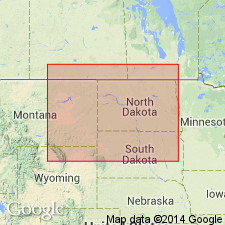
- Usage in publication:
-
- SCOLITHUS sandstone
- Modifications:
-
- Overview
- AAPG geologic province:
-
- Williston basin
- Powder River basin
Summary:
Tentatively excluded from Deadwood formation in northern Black Hills, SD and WY, in Williston and Powder River basins following the usage of McCoy (1952) [who elevated it to formational rank and gave it the formal name Aladdin sandstone]. May prove to be a sandstone within Deadwood formation in subsurface of Williston basin. Early Ordovician fossils have been collected in the uppermost Deadwood formation just below this sandstone (Lochman, Duncan, 1950), and Middle Ordovician? shale [Icebox shale] overlies it. Ordovician in age.
Source: GNU records (USGS DDS-6; Denver GNULEX).
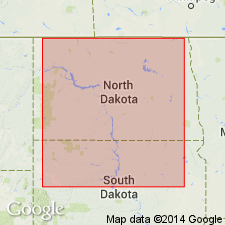
- Usage in publication:
-
- SCOLITHUS sandstone
- Modifications:
-
- Overview
- AAPG geologic province:
-
- Williston basin
- Powder River basin
Summary:
Considered the top bed of Deadwood formation in outcrops in northern Black Hills, SD and WY, in Williston and Powder River basins. Assigned an Early Ordovician age based on conformable relations with underlying strata of Deadwood formation of Early Ordovician age.
Source: GNU records (USGS DDS-6; Denver GNULEX).
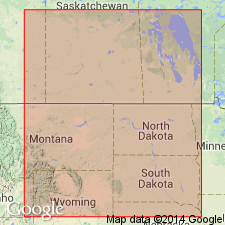
- Usage in publication:
-
- SCOLITHUS sandstone
- Modifications:
-
- Overview
- AAPG geologic province:
-
- Williston basin
- Powder River basin
Summary:
Sedimentary considerations weigh heavily in favor of leaving SCOLITHUS sandstone in Deadwood. Reasons are reviewed. Is Ordovician in age.
Source: GNU records (USGS DDS-6; Denver GNULEX).
For more information, please contact Nancy Stamm, Geologic Names Committee Secretary.
Asterisk (*) indicates usage by the U.S. Geological Survey. Other usages by state geological surveys.
"No current usage" (†) implies that a name has been abandoned or has fallen into disuse. Former usage and, if known, replacement name given in parentheses ( ).
Slash (/) indicates name does not conform with nomenclatural guidelines (CSN, 1933; ACSN, 1961, 1970; NACSN, 1983, 2005). This may be explained within brackets ([ ]).

